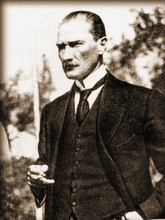 Arabanın içinde bir kadın.
Arabanın içinde bir kadın.This evening, while working with Rosetta Stone's Turkish tutorials, this kind of image (see note below) and caption was shown. Clearly, it refers to a woman in a car. But I have a question.
First, let's break it down.
- Bir kadın = a woman
- içinde = inside, within, in
- araba = car
One of my textbooks reports the following under the caption "Compound Posessive":
The suffix for the possessor: If the word ends in a vowel, add -nın/-nun (back vowel versions). Kedi (cat); kedinin (cat's)So, in this case, if I'm following the Rosetta Stone guide correctly, the car here is the possessor. In effect, the car possesses within it a woman.
That translation feels awkward to me. Wouldn't it be the woman who possesses the car? Or am I confusing ownership with possessive grammar? :^)
Note: This is not the image from Rosetta Stone. I just couldn't clip out the exact image used in Rosetta Stone, so I borrowed this one from Fotosearch.com.


2 comments:
Good one! First off, as it stands "Arabanın içinde bir kadın" isn't a full sentence, just a caption; it means "A woman in a/the car." The tricky part is içinde. "iç" is "inside, interior part," and that's what's being possessed by the car. So semi-literally the caption is, "In the car's interior, a woman."
My own question is, what's her phone number? ;^)
Excellent answer to my question! Mersi!
Yes, nice photo, eh? No law against eye-candy (göz-şeker)!
Post a Comment